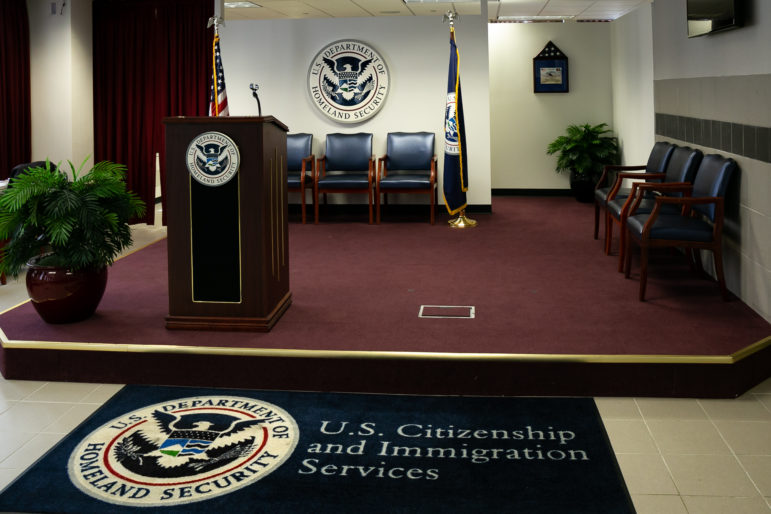
Adi Talwar
Citizenship ceremony space at the Citizenship and Immigration Services (USCIS) offices in downtown Manhattan in 2016. Much has changed since then.Lea la historia original, en español.
If there is one figure that illustrates the Trump administration’s systematic effort to dismantle the immigration system, that would be the more than 400 policy changes the regime has made in its less than four-year lifespan.
“The focus on immigration is unprecedented,” says Jessica Bolter, an immigration and refugee associate policy analyst at the Migration Policy Institute.
Compared to previous administrations, the Trump administration has far outpaced others in its effort to transform immigration policy, which is why the Migration Policy Institute’s most recent report notes that “merely rescinding each of the hundreds of changes cataloged in this report would require a massive financial, personnel, and bureaucratic investment.”
“Thus, whatever the outcome of the election, it seems likely that many of the changes to policy and to political discourse around immigration that have emerged since 2017 are likely to continue to shape the U.S. immigration system for years to come,” the report concluded.
“What is unique about this administration is that immigration has been a core issue both before [the election] and as president,” emphasizes Bolter, who is one of the report’s authors. “We haven’t seen a president so focused on immigration, and we haven’t seen a president who has devoted the amount of time and resources to changing immigration laws—that’s unique to this administration.”
The level of obsession with immigration issues, to the diminishment of others, also makes the Trump administration unique. When other governments have faced a crisis, presidents tend to focus their efforts on emergency responses, and immigration issues are pushed to the sidelines. This has not happened under Trump.
“This administration has been unique in prioritizing immigration policy changes, even during the pandemic,” says Bolter. Instead of diverting attention to the serious economic crisis and/or the public health crisis across the country, the pandemic instead boosted the administration’s immigration agenda. “It has presented opportunities, in the name of the pandemic, to unilaterally accomplish policy goals few predicted possible,” reads the report.
Reforms amid the pandemic
During the pandemic, the Trump administration has advanced 63 immigration “reforms,” including some of the boldest actions to date, such as invoking a 1944 public health statute allowing the removal of asylum seekers without first hearing their claims. It has also threatened to sanction countries that do not accept deportations of people who have been infected with COVID-19.
According to the report, three particular actions during the pandemic allowed this administration to achieve the goals it had been working toward in previous years.
The first came in March, when the CDC director issued an order “suspending introduction of certain persons from countries where a communicable disease exists.” This effectively closed the possibility of applying for asylum for those arriving at the southern border of the United States, and so the Trump administration accomplished in one move what it had been working on for two years: making it more difficult and reducing the criteria for asylum eligibility.
This was followed by April’s change suspending the issuance of visas to people outside the United States who were parents, adult children and siblings of U.S. citizens or spouses of permanent residents, diversity visa winners and almost all types of employment-based immigrants. This action “mirrored earlier attempts by the administration to convince Congress to limit family migration, as 80 percent of the blocked immigrants come from family-based categories,” indicates the report.
The third blow came in June when the administration suspended some temporary work programs “that the administration has spent years scrutinizing, as illustrated by the fact that denials of H-1Bs have more than doubled under the Trump administration.”
At the same time, the Trump administration has extended the mechanisms for pursuing and advancing deportations as much as possible nationwide. ICE continued operations during the pandemic. Immigration detention centers had outbreaks of COVID-19, and several of them still report new cases each week. Also, immigration courts continued to operate during the pandemic, despite calls from immigration judges, attorneys, and ICE prosecutors to close the courts.
Unprecedented numbers of changes, monumental impacts
The Trump administration’s fixation with immigration has been monumental and unprecedented, and so has the impact it has had on immigrants’ lives and on institutions that work on immigration issues.
“While the enforcement arms of the U.S. immigration system have pressed forward through the pandemic, USCIS temporarily suspended in-person services and left legal immigrants in the United States with limited options,” states the report.
For example, USCIS refused to grant automatic extensions to temporary visitors, which put many of them in an uncomfortable limbo watching the remaining time on their visas wind down.
According to Bolter, Trump’s immigration agenda is based on two priorities: to stop immigration along the country’s southern border and to close the door to those seeking refuge. The latter goal is much closer to reality: The Trump administration plans to admit a maximum of 18,000 refugees in the fiscal year 2020, well below the cap of 30,000 that ended on September 30, 2019. “This would be the lowest number of refugees resettled by the U.S. in a single year since 1980, when Congress created the nation’s refugee resettlement program,” says the Pew Research Center.
On the southern border, arrests in fiscal year 2019 reached a 12-year high of 851,508, with most of these taking place during the spring and summer months. The numbers began to tail off in summer 2019, and 2020 began with an eighth month of decreasing arrest numbers. Recent reports, however, indicate a new surge of crossings.
Ultimately, the vast majority of these changes in immigration policy have been achieved through executive orders, thus bypassing Congress. However, on the few occasions when Congress has been consulted, it has supported the administration, as when Congress authorized the hiring of 65 additional ICE Homeland Security Investigations officers.
Congress has only formally rejected three immigration policies proposed by the Trump administration: The first was the two blockages of the president’s emergency declaration for wall funding, which the president vetoed on both occasions. The second was to restrict ICE from using information about sponsors of unaccompanied children. The third was reversing a USCIS policy that made it more difficult for foreign-born children of U.S. military personnel to receive citizenship.
For the hundreds of other changes made by the Trump administration, as the report notes, “Congress has been silent.”








